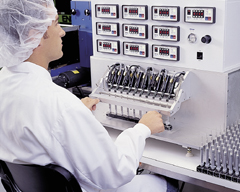Dispense valve controllers help syringe manufacturer enhance process control
According to a recent study, over one million accidental needlesticks are reported each year. Sixty-one percent involve the use of disposable syringes, a situation Retractable Technologies Inc. (Little Elm, TX) hopes to remedy with their VanishPoint. What makes the VanishPoint unique is that it is the first disposable syringe to feature a needle that automatically retracts after injection, greatly reducing the chance of an accidental needlestick.
Helping the company satisfy the growing demand for their new product are the precision dispensing systems used to make a critical adhesive deposit.
Accuracy is critical
Each stainless steel needle, or cannula, must be bonded to a polypropylene hub with a specific amount of UV-cure adhesive. The ability to regulate, document and repeat the amount of adhesive allowed to flow into the hub's recess is critical, according to production manager Jim Hoover.
Underapplication could result in the cannula separating from the hub during injection or retraction. Overapplication must also be avoided, since excess adhesive could build up on the hub. This would prevent the needle from retracting, and defeat the purpose of the new product.

Air-powered benchtop dispensers from <%=company%> (East Providence, RI) had proven accurate and reliable in building the syringes used in the clinical trials, so Retractable Technologies asked them to help design a semiautomated system to meet their expanding production needs.
Unlike the benchtop operation in which an operator applies adhesive to one syringe at a time, the manufacturer now needed a system capable of making 10 deposits at once. While output needed to be increased, accuracy and process control had to be maintained.
After discussing the new objectives, EFD recommended their Model 740V, an adjustable needle valve designed to make microdeposits of low- to medium-viscosity fluids. Deposit size, they explained, would be determined by a combination of fluid pressure, flow control setting, tip size and valve open time.
A new way to improve process control
To take full advantage of the 740V's precision dispensing capabilities, EFD recommended pairing each valve with its dedicated, microprocessor-based Valvemate 7000 controller. This would ensure the required process control by allowing each valve's dispense time setting to be adjusted in increments as small as 0.001 seconds -- without stopping the production line.
Realizing the benefits the "one valve/one controller" approach could bring to their dispensing operation, Retractable Technologies designed a semiautomated tabletop assembly machine and had it fabricated by a local machine builder.
With this setup, 10 valves are fixtured in a rack, with 10 controllers mounted above them. A manifold at the rear of the machine distributes plant air to each valve/controller system, while adhesive is supplied from pressurized tank reservoirs.
The individual controllers made valve setup and adjusting the deposit size fast and easy. Once optimal settings were determined for the first system, it was a simple matter to program the remaining nine to produce the same results.
Retractable Technologies' new dispensing method has proven to be fast, efficient and, most important, accurate and repeatable. After placing a loaded work holder in position, the operator simply lowers a bar to cycle the valves and make 10 identical deposits.
Repeatability and more
Hoover says the company's decision to go with dedicated controllers has been a tremendous help in maintaining process control. "They make it easy for us to set specific operating parameters for air pressure, fluid pressure and dispense time, but still allow the operator to make minor adjustments within a narrow range of approved settings," he says.
"The advantage of this approach," he continues, "is that if something goes amiss and you are operating within the documented parameters, you know you need to look elsewhere to isolate the cause of the problem. It literally forces you to take the proper corrective action."
"We needed something that was accurate, repeatable and easily validated," he concludes, "and we found it. We're very pleased with the accuracy of these systems, particularly with their repeatability."
"With a lot of equipment, when you shut down at the end of the day and start up again the next morning, it's hard to duplicate the results you got the day before. With the EFD valves and controllers, we never have that problem."
With contribution from Ursula Jones
Managing Editor, Medical Design Online
ujones@medicaldesignonline.com
